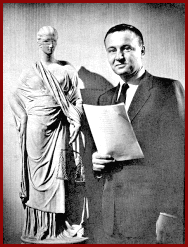
Sports announcer Jim McKay is seen as the reporter on CBS television's "The Verdict Is Yours"
Thursday, May 8, 2003
Page 14
REMINISCING (Column)
TV Courtroom Shows Proliferate in the Late 1950s
By ROGER M. GRACE
In the aftermath of the unexpected commercial success of “Traffic Court”—which started out in summer, 1957 as a KABC-TV public affairs program—other shows featuring simulated courtroom proceedings were added one by one to television schedules.
Newsweek reported on Jan. 12, 1959:
“In the past year and a half, since Station KABC-TV’s pioneering ‘Traffic Court’ first appeared, more than half a dozen new, documentary-type courtroom shows have gone on the air in California and several, via the networks and syndication, around the nation. In the next two weeks two more will have their debuts.”
Edgar Allan Jones Jr., who portrayed the judge on “Traffic Court,” was quoted in a Nov. 11, 1958 UPI story as remarking:
“We’re involved in a court cycle, and I’m confident it will last as long as the westerns, maybe longer. They’ll go on because they’re realistic and don’t ham it up.”
From the late 1950s through the early 1960s, courtroom dramatizations did enjoy popularity. A resurgence of courtroom shows later featured a twist: actual cases were decided in simulated courtroom settings in the form of binding arbitration. That started in 1981 with former Los Angeles Superior Court Judge Joseph Wapner, presiding over “People’s Court.”
Confining attention to shows inspired by KABC’s “Traffic Court”….
•“Traffic Court,” itself, is the logical place to start. It went onto ABC’s network roster, as a weekly show, June 18, 1958. “Day in Court,” a five-day-a-week production with Jones presiding Mondays, Wednesdays and Fridays over both civil and criminal cases (alternating with actor William Gwinn, who handled domestic relations cases), started Oct. 13, 1958 on ABC. Unlike “Traffic Court,” which was scripted only in terms of an outline [see sample page], “Day in Court” and its offspring had scripts with dialogue [sample page]—but with Jones ad libbing his ruling. A weekly nighttime version, “Accused,” starring Jones, was launched Dec. 10, 1958 on the same network. The popularity of “Day in Court” was such that a spinoff, “Morning Court” was launched Oct. 10, 1960 on ABC, seen Mondays through Fridays, featuring Gwinn, with school board member Georgianna Hardy (wife of attorney Jack W. Hardy and former reviewer on KNXT, Channel 2’s “Cavalcade of Books”) as the alternating jurist.
|
|
Sports announcer Jim McKay is seen as the reporter on CBS television's "The Verdict Is Yours" |
|
•“The Verdict Is Yours” was a daytime courtroom show aired by CBS. It began Sept. 2, 1957, well ahead of “Day in Court.” Unscripted, it featured actual lawyers playing the lawyers and judges. Unlike the ABC shows, real cases were not used. Sportscaster Jim McKay was the original “reporter,” providing commentary on the trials. He was succeeded in 1960 by newsman Bill Stout. The program aired weekly on CBS’ nighttime schedule in the summer of 1958. As on “They Stand Accused”—which CBS broadcast weekly from Jan. 18, 1949 through May of that year (with the program then bouncing to Du Mont)—members of the audience served as the jury, rendering verdicts.
•“Divorce Court” was hatched by KTTV, Channel 11, in 1958, and syndicated nationally, on the new medium of videotape [see ad for syndication rights]. The show outlasted other courtroom programs that began in that era, remaining on the air until 1969. (It was reprised in 1984-91, with retired Los Angeles Superior Court Judge William Keene as the judge, and is currently enjoying yet another revival.) The original version featured KTTV’s longtime man-with-a-portable-mike, Bill Welsh, as the reporter-announcer. Actual members of the State Bar performed as lawyers. This show was distinctive; to some, it was bold, others saw it as raunchy. It dealt frequently with adultery, a subject that had been strictly taboo in earlier days of television and which, on rare occasions when alluded to on the networks in the late 1950s, was treated gingerly if not obliquely. The Los Angeles County Bar Assn. was a detractor of the show, as I’ll discuss next week.
•“People’s Court of Small Claims” was on the air in 1959, broadcast weekly on KCOP, Channel 13, and syndicated nationally. Portraying the judge was sedate USC Law Professor Orrin B. Evans (who became dean in 1963).
Too, there were courtroom shows, such as “Night Court,” that originated on KTLA, Channel 5—shows that were strictly for entertainment and about as authentic as an Elvis Presley autograph scrawled on a DVD cover. As time went on, they strove increasingly for shock value, with prostitution seemingly being the most prevalent offense that prosecutors charged.
Copyright 2003, Metropolitan News Company